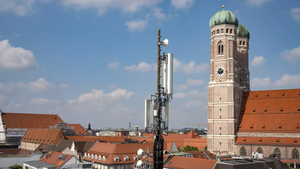CyOptics Tries On Triquint
Startup claims it can turn around former Agere optics group. Can it be saved or is it just another opto-nightmare?
May 13, 2005

Having completed the $23.5 million acquisition of TriQuint Semiconductor Inc.'s (Nasdaq: TQNT) optoelectronics operations, startup CyOptics Inc. says it's undaunted about joining the big players in the optical components game.
The six-year-old startup, founded to build 40-Gbit/s modulators, sees the deal as a chance to step into a bigger market, despite the tough track record of previous big-deal acquisitions in optics.
"We're better positioned in terms of a broad product portfolio," says Ed Coringrato, CyOptics CEO. (Prior CEO John Pilitsis stepped down on Jan. 1 in an "honest-to-goodness retirement," Coringrato says.)
The deal closed April 29, as CyOptics announced on Wednesday. TriQuint has a separate sale still pending, handing the Breinigsville, Pa., site to a developer that plans to build a research park (see TriQuint Exits Optics).
In addition to the products, CyOptics -- based in Pennsylvania and headed by former Lucent Technologies Inc. (NYSE: LU) employees including Coringrato -- was interested in inheriting the business for its history. TriQuint had acquired its optoelectronics organization from Agere Systems Inc. (NYSE: AGR.A), meaning the organization traces its roots back to Bell Labs and AT&T Corp. (NYSE: T).
"What they get out of it, in addition to the obvious, is brand name," says Lawrence Gasman, an analyst with Communications Industry Researchers Inc. (CIR). "I don't want to sound too nostalgic, but AT&T technology -- that counts for something."
Purchasing TriQuint's $30 million-a-year optoelectronics business is a big step for a startup that, according to one industry source, has just $4 million in yearly revenues. And the risks are obvious, given the brutal track record of optical components acquisitions.
Avanex Corp. (Nasdaq: AVNX) and Bookham Inc. (Nasdaq: BKHM; London: BHM) each acquired their way into being broad-based suppliers, with Bookham grabbing Nortel Networks Ltd.'s (NYSE/Toronto: NT) components group in 2002 and Avanex buying Alcatel Optronics and most of Corning Inc.'s (NYSE: GLW) components business in 2003 (see Bookham Buys Nortel's Components Biz, Avanex to Buy Alcatel, Corning Units, and Avanex Deal Reshapes Sector).
Both were making a run at grabbing the No. 2 spot behind unquestioned market leader JDS Uniphase Corp. (Nasdaq: JDSU; Toronto: JDU). But that dogfight hasn't been so glamorous, as Avanex and Bookham have been mired in losses (see Components Competition Is Killing and Avanex Does a French Trim).
TriQuint was in the same boat after paying $40 million for Agere's optoelectronics group in January 2003 (see TriQuint to Acquire Agere's Optics). TriQuint expected sales to reach $50 million to $75 million per year, but the optoelectronics division never even reached $10 million in a quarter. "From what I saw of them, they were pretty unrealistic about what they were buying," Gasman says.
Realizing optics would never be the business it expected, TriQuint called it quits.
But TriQuint did mange to bring the unit to the cusp of profitability after one last round of cuts in November (see TriQuint to Cut 200). TriQuint's 10-Q form filed Wednesday with the SEC says that for the quarter ended March 31, the optoelectronics business lost $98,000 on revenues of $7.4 million, compared with a $2.6 million loss on revenues of $10.2 million for the same quarter a year ago.
That makes CyOptics' job a bit easier. "A lot of the restructuring was already done," Coringrato says.
The 10-Q also breaks down details of the sale. CyOptics' payment included $13.5 million cash, a $5.5 million promissory note, and preferred stock representing 10 percent of CyOptics' voting shares.
CyOptics's press release says the TriQuint deal was worth $23.5 million, which gives those voting shares a value of $4.5 million.
Coringrato believes his company can escape the optical whirlpool of losses. "It's an industry we think is in a growth mode again."
Industry scuttlebutt is that Agere lost customers during the long process of trying to sell the optics division, but Coringrato claims TriQuint got things stabilized. "It was a good customer base, a Tier 1 customer base," he notes. "The customer traction they had was very good."
One advantage CyOptics has is that it doesn't seem to have TriQuint-like expectations. Gasman says optics can still be a strong business if a company goes in with the right attitude -- to wit: "It's all about cutting costs."
CyOptics picks up about 200 employees in the deal, bringing its total to 260. Some layoffs were involved, as usual, but "not as many people as you would think," Coringrato says. "The companies on both sides were really running lean." CyOptics will move its manufacturing from an Israel fab -- which is being kept for R&D work -- to TriQuint's Breinigsville and Matamoros, Mexico, facilities.
That migration will take time and money. To help, CyOptics closed a $24 million cash-and-debt financing round from investors including EuroFund Partners, Jerusalem Venture Partners, Sprout Group, and TowerBrook Capital Partners (a new firm founded by former executives of Soros Private Equity Partners). (See CyOptics Raises $24M .) The round, announced Wednesday is CyOptics' sixth, putting the company at a total of $111 million raised since 1999.
— Craig Matsumoto, Senior Editor, Light Reading
You May Also Like










